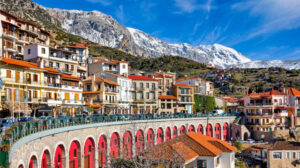The Greek winter holiday home market continues to face significant challenges, despite the relative recovery recorded in previous years.
Factors such as general economic uncertainty, changing climatic conditions and rising borrowing costs have created a difficult environment for the development of this market.
In particular, as noted in the latest GEOAXIS Winter Residential Winter Home Values Watch 2024/2025, general uncertainty about the future, the absence of an extended winter, high borrowing rates and significant construction costs are negatively impacting this market. Although compared to the historic highs of 2008, values are still down more than half
In terms of annual change 2024 – 2023), a minimal positive change in the asking sales prices of winter holiday homes is recorded for Arachova in Boeotia and Karpenisi in Evritania of 2.01% and 1.49% respectively. The selling prices in Agios Athanasios of Pella and Trikala of Corinth remain stable.
In more detail:
* In Arachova, from 1,594 euros/sq.m. in 2023, the asking price currently stands at 1,626 euros/sq.m. (2.01%).
* In Agios Athanasios, from 1,053 euros/sq.m. in 2023 to 1,063 euros/sq.m. (0.95%).
* In Karpenisi, from 1,008 euros/sq.m. in 2023 to 1,023 euros/sq.m. (1.49%).
* In Trikala, Corinthia, from 1,097 euros/sq.m. in 2023 to 1,106 euros/sq.m. (0.82%).
Change 2024 – 2008
Compared to the 2008 highs, there is a very large and horizontal decrease in the four study areas, averaging -55%.
In more detail:
* The largest decrease is in Agios Athanasios, where the value of 3,301 euros/sq.m. in 2008 is now 1,063 euros/sq.m. (-68%).
* In Karpenisi, from 2,308 euros/sq.m. in 2008 to 1,023 euros/sq.m. today (-56%).
* In Trikala, Corinthia, from 2,250 euros/sq.m. in 2008 to 1,106 euros/sq.m. today (-51%).
* In Arachova, from 3,000 euros/sq.m. in 2008, today at 1,626 euros/sq.m. (-46%).
Demand and Supply
Despite the almost sub-doubling of prices compared to the beginning of the crisis (2008), demand is extremely weak. Several developers who invested in luxury homes with a total cost of more than 1,500 euros/sqm find themselves stranded, as even selling below cost does not trigger demand. The example of Livadi in Arachova is typical, where dozens of complexes remain completed with no prospect of immediate sale.
The median total area of a country house (including auxiliary spaces) is 144 sq.m., with the largest areas in Arachova (160 sq.m.) and the smallest in Trikala Corinthia (130 sq.m.).
The median age of a holiday home is 22.5 years, with the oldest in Karpenisi (37 years) and the youngest in Arachova and Agios Athanasios (17 years).
According to Geoaxis estimates, uncertainty about the near future combined with the shrinking disposable income continues to make winter holiday homes an off-agenda option for the majority of Greeks, resulting in stagnation and possible future compression of values.
The study areas include Arachova in Boeotia, Agios Athanasios in Pella, Karpenisi in Evritania and Trikala in Corinthia. The choice was made to cover indicatively the famous winter tourist destinations of the country. In each region, locations with typical characteristics were selected, taking into account the homogeneity and reliability of the available data.
Who buys winter residences?
Buyers of winter homes in Greece, according to converging estimates from real estate consultants contacted by APE/MPE, come mainly from:
Domestic buyers: The majority of the small Greek population comes mainly from urban centers such as Athens and Thessaloniki, choosing areas that combine easy access and tourist development (e.g. Arachova, Trikala in Corinthia).
Buyers from abroad come from Cyprus, mainly due to close cultural ties, as well as from Balkan countries from Romania, Serbia, and Bulgaria, with interest in areas close to the border. Also, buyers from Germany, the UK, and Scandinavian countries are looking for winter residences in areas with ski resorts. In recent years there has been interest from Israelis, mainly for investment opportunities.
Most foreign buyers prefer areas with good tourist infrastructure, natural beauty and the possibility of short-term rentals for a return on investment.
Climate change and its effect on winter housing.
According to international reports, ski resorts, which are a key incentive for the purchase of winter holiday homes, are recording a decline in operating days due to insufficient snow cover. In particular, areas located at lower altitudes (<2,500 m) face even greater difficulties. In Europe, many banks avoid financing projects for ski resorts at low altitudes, as they are considered unsustainable in the long term. Increased energy prices are a burden on ski resorts, reducing their ability to operate and negatively affecting local real estate markets in regions of Europe and our country. As Yannis Xylas, managing director of Geoaxis, tells APE/MPE, just as areas in the Alps are trying to become a 12-month destination by organizing summer activities, Greek winter destinations could attract tourism with similar actions. It requires planning, consensus, and vision from local actors (Municipalities, Hoteliers, Professionals, Chambers of Commerce, etc.). It is a difficult situation for our country where individual initiative rather than collective initiative prevails. In any case, Mr. Xylas estimates that in the long term due to climate change, we will see an increase in interest in winter destinations, especially near Athens.
Ask me anything
Explore related questions





